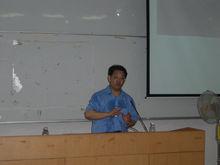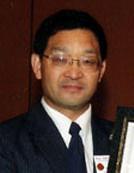人物經歷
1982: 學士,武漢水利電力大學(現屬武漢大學),水利工程
1985: 碩士,美國亞利桑那大學,土壤和水科學
1990: 博士,美國亞利桑那大學,土壤和水科學,兼修數學、計算機和水文學
 張仁鐸
張仁鐸1986-1990: 助研,美國亞利桑那大學,土壤和水科學系及數學系1990-1993: 博士後,美國農業部國家實驗室(加州大學)
1993-1997: 助理教授,美國懷俄明大學,再生資源系
1997-2001: 副教授,美國懷俄明大學,再生資源系
2002-2005: 教授,美國懷俄明大學,再生資源系
2001-2004: 教育部“長江學者獎勵計畫”特聘教授,武漢大學,水利工程系
中山大學,環境科學與工程學院,環境科學與環境工程專業博士生導師,廣東省環境污染控制與修復技術重點實驗室副主任。
國際“水文學雜誌”(J. Hydrology)編委;
"美國土壤學會雜誌"(SSSAJ)編委;
國際"環境質量雜誌"(JEQ)編委。
研究方向
污染物質在土水環境中的物理、化學和生物遷移轉化過程研究;土壤溫室氣體研究;土壤重金屬及有機污染的微生物治理;地下水資源污染修復與控制;時空變異理論和地質統計方法在環境問題中的運用;流域非點源污染研究;水土環境模擬方法研究。
主講課程
1.環境微生物學(本科生)
2.空間變異理論及套用(研究生)
3.土壤水動力學(研究生)
4.環境土壤學(研究生)
獲獎記錄
優秀導師獎 (美國懷俄明大學,1997,1998)
卓越教授獎 (美國懷俄明大學,1999)
“先鋒號”獎 (美國懷俄明大學,2003)
美國農業科學學會(ASA) Fellow獎(2004)(該科學學會的最高獎勵)
美國土壤科學學會(SSSA) Fellow獎(2004)(該科學學會的最高獎勵)
主要貢獻
主要科研課題
在美國任職期間,從美國自然科學基金會、農業部、環保局、能源部、地質局、州政府、大學及其它有關的資助系統申請到五百多萬美元的科研經費,承擔了30多項科研項目。
1. 土壤水動力參數的尺度效應和空間變異性,國家自然科學基金項目(優秀創新項目) (主持),2002-2005。
2. 寧蒙河套灌區水平衡機制及耗水量研究,國家自然科學基金重點項目(主持人之一),2002-2006。
3. 再生水資源化與灌溉利用技術,國家高技術研究發展計畫(863計畫)項目(主要研究人員),2002-2006。
4. 三維地下水流場新測量方法和計算方法的研究,國家自然科學基金項目(主持),2006-2009。
5. 污染物的擴散、摻混及輸移理論,國家自然科學基金項目(海外傑出青年項目) (主持人之一),2006-2009。
6. 土壤放射性污染的過程模擬與修復,中國與白俄羅斯政府間科技合作項目,(中方主持人),2007-2008。
7. 礦山污染生態修復理論與技術研究,廣東省自然科學基金研究團隊項目(主持人之一),2007-2009。
8. 土壤碳匯的研究:物理、化學和生物過程的耦合,國家自然科學基金項目(主持),2008-2010。
招收和指導研究生
美國懷俄明大學:8名碩士,12名博士(已畢業)
武漢大學:2名碩士,3名博士(已畢業)
中山大學:4名碩士,1名博士(已畢業),5名碩士生,12名博士生(在讀)
論文著作
發表學術論文100多篇(其中SCI收錄100餘篇,EI收錄20餘篇),出版學術專著5部。代表性論文如下:
1. Zhang,R. 2005. Applied geostatistics in environmental science. Science Press USA Inc.
2. 張仁鐸 著,2005,空間變異理論及套用,科學出版社。
3. 張仁鐸 編著,2007,環境水文學,中山大學出版社。
4. 阮本清,張仁鐸,李會安 著,2008,河套灌區水平衡機制及耗水量研究,科學出版社。
5. Zhang,R.,A. W. Warrick and D. E. Myers,1990. Variance within a finite domain as a function of sample support size. Math Geology 22:107-121.
6. Zhang,R.,A. W. Warrick and J. F. Artiola,1992. Numerical modeling of free-drainage water samplers in the shallow vadose zone. Advances in Water Resources 15:251-258.
7. Zhang,R.,A. W. Warrick and D. E. Myers,1992. Improvement of soil textural estimates using spectral properties. Geoderma 52:223-234.
8. Zhang,R.,D. E. Myers,and A. W. Warrick,1992. Estimation of spatial distribution of soil chemicals using pseudo-cross-variograms. Soil Science Society of America Journal 56:1444-1452.
9. Zhang,R.,K. Huang and M. Th. van Genuchten,1993. An efficient Eulerian-Lagrangian method for solving convection-dispersion transport problems in steady and transient flow fields. Water Resources Research 29:4131-4138. 10. Zhang,R.,A. W. Warrick,and D. E. Myers,1994. Heterogeneity,plot shape effect and optimum plot size. Geoderma 62:183-197.
11. Zhang,R.,and M. Th. van Genuchten,1994. New models for the unsaturated soil hydraulic properties. Soil Science 158:77-85.
12. Zhang,R.,K. Huang,and J. Xiang,1994. Solute transport in large homogeneous and heterogeneous soils. Advances in Water Resources 17:317-324.
13. Zhang,R,S. Rahman,G. F. Vance,and L. C. Munn,1995. Geostatistical analyses of trace elements in soils and plants. Soil Science 159:383-390.
14. Zhang. R.,1995. Prediction of solute transport using a transfer model and the convection-dispersion equation. Soil Science 160:18-27.
15. Yang,J. R. Zhang,and J. Wu,1996. An analytical solution of macrodispersivity for adsorbing solute transport in unsaturated soils. Water Resources Research 32:355-362.
16. Zhang,R. J. Yang,and Z. Ye,1996. Solute transport through the vadose zone: field studies and stochastic analyses. Soil Science 161:270-277.
17. Zhang,R.,J. D. Hamerlinck,S. P. Gloss,and L. Munn,1996. Determination of non-point source pollution using GIS and numerical models. Journal of Environmental Quality 25:411-418.
18. Zhang,R.,and J. Yang,1996. Iterative solution of a stochastical differential equation: an efficient method for simulating soil variability. Geoderma 72:75-88.
19. Zhang,R.,1997. Determination of soil sorptivity and hydraulic conductivity from the disc infiltrometer. Soil Science Society of America Journal 61:1024-1030.
20. Zhang,R.,P. Shouse,and S. Yates,1997. Use of pseudo-crossvariograms and cokriging to improve estimates of soil solute concentrations. Soil Science Society of America Journal 61:1342-1347.
21. Zhang,R.,1997. Infiltration models for the disc infiltrometer. Soil Science Society of America Journal 61:1597-1603.
22. Zhang,R.,1998. Estimating soil hydraulic conductivity and macroscopic capillary length from the disc infiltrometer. Soil Science Society of America Journal 62:1513-1521.
23. Zhang,R.,P. Shouse,and S. Yates,1999. Estimates of soil nitrate distributions using cokriging with pseudo-crossvariograms. Journal of Environmental Quality 28:424-428.
24. Zhang,R.,A. Krzyszowska-Waitkus,G. F. Vance,and J. Qi. 2000. Pesticide transport in field soils. Advances in Environmental Research 4:59-68.
25. Zhang,R.,2000. A generalized transfer function model for solute transport in heterogeneous soils. Soil Science Society of America Journal 64:1959-1602.
26. Zhang,R.,A. L Wood,C G. Enfield. 2003. Stochastical analysis of surfactant enhanced remediation of DNAPL contaminated soils. Journal of Environmental Quality 32:957-965.
27. Hao,X.,R. Zhang,and A. Kravchenko. 2005. A Mass-conservative Switching Method for Simulating Saturated-unsaturated Flow. Journal of Hydrology 311: 254-265.
28. Wang,K.,and R. Zhang. 2005. Testing the Pore-Solid Fractal Model for the Soil Water Retention Function. Soil Science Society of America Journal 69:776-782.
29. Liu,H.H.,R. Zhang,and G. S. Bodvarsson. 2005. An Active Region Model for Capturing Fractal Flow Patterns in Unsaturated Soils: Model Development. Journal of Contaminated Hydrology 80:18-30.
30. Wang,K.,R. Zhang,and H. Yasuda. 2006. Characterizing scale-dependent heterogeneity of soil water movement by dye infiltration experiments. Journal of Hydrology,328:559-571.
31. Wang, K.,R. Zhang, Y. Hiroshi. 2009. Characterizing heterogeneous soil water flow and solute transport using information measures. Journal of Hydrology 370: 109–121.
32. Sheng, F., K. Wang,R. Zhangand H. Liu. 2009. Characterizing soil preferential flow using iodine–starch staining experiments and the active region model. Journal of Hydrology 367: 115–124.

